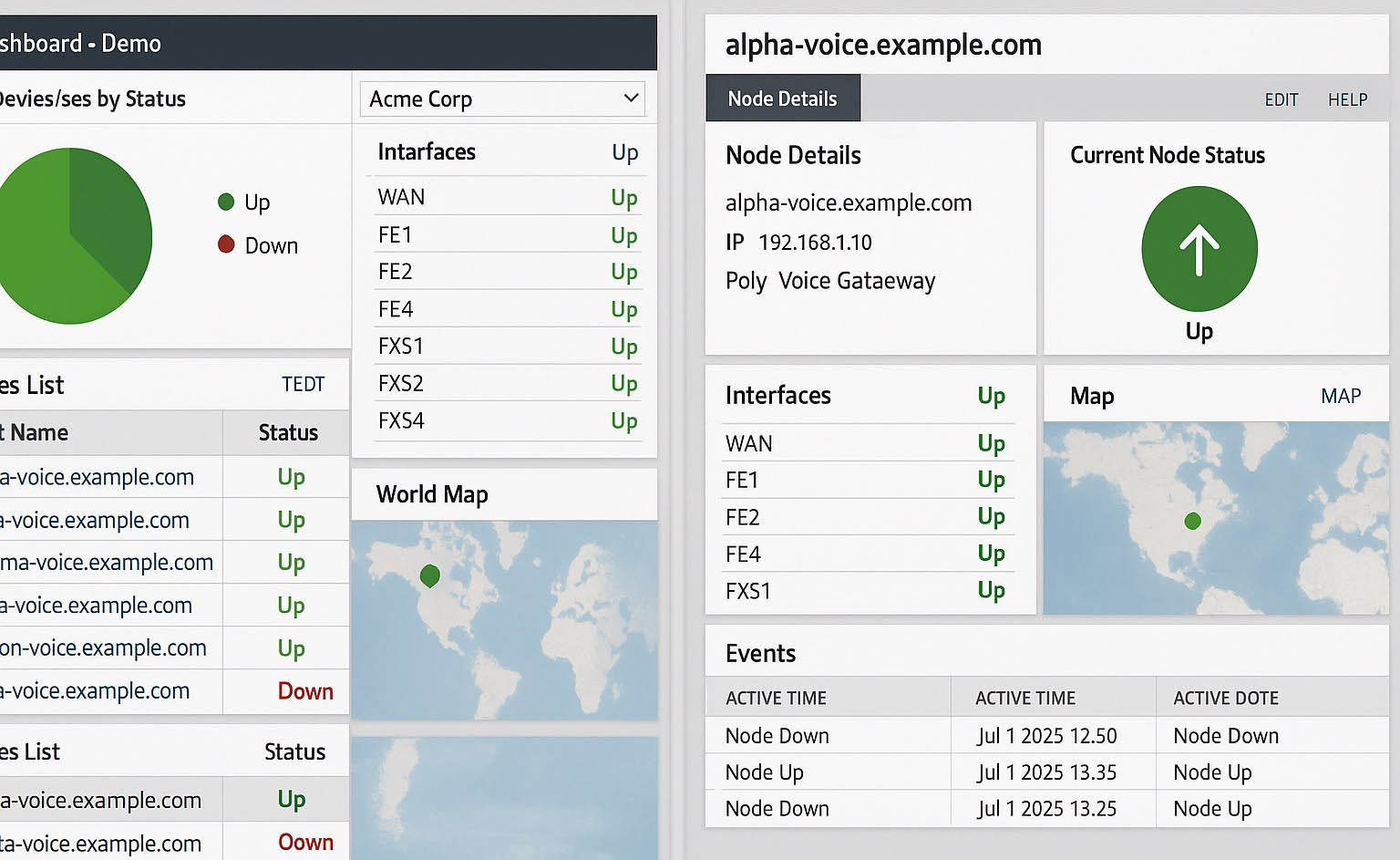A Managed Service Provider (MSP) faced a critical challenge: how to deliver customers reliable, real-time visibility into their DataRemote devices through the existing SolarWinds monitoring platform, while simultaneously driving a large-scale shift away from traditional analog POTS lines toward modern VOIP-based services.
What is DataRemote? DataRemote manufactures customer premises equipment (CPE) that plays a crucial role in networking and failover scenarios. These devices often provide redundant WAN connectivity via cellular or wired links and include analog/FXS ports that had historically been used for POTS voice delivery. As the MSP pushed to retire costly, legacy POTS infrastructure, DataRemote units became increasingly important in enabling VOIP-based replacements and ensuring continuity of critical communication services.
In many customer environments, these devices serve as the last line of communication continuity, making their availability, performance, and health status essential for both VOIP service delivery and MSP reporting obligations.
The MSP’s issue was straightforward yet complex:
- No SNMP Support: DataRemote devices do not expose traditional SNMP MIBs for polling health, port states, or availability. This eliminated the most common SolarWinds integration method.
- Webhooks Without Ingestion: DataRemote offers vendor “sevhooks” (server-side webhooks) that push device events when something changes. Unfortunately, SolarWinds does not support ingesting webhooks natively.
- Unreliable Delivery: Even if webhooks could be consumed, they do not guarantee delivery. In a managed services environment, losing an event could mean reporting a device as “up” when it is actually down, an unacceptable risk.
- Polling API Limitations: DataRemote also provides an API that returns device statuses. However, it is not designed for high-frequency monitoring and applies throttling limits. A polling-only approach would not be scalable across hundreds of devices.
The MSP needed a solution that provided real-time visibility, reliability despite missed events, and seamless integration into SolarWinds so that customer reports, dashboards, and alerts worked as if DataRemote devices were natively supported.
Solution Delivered
We designed and implemented a hybrid monitoring framework that bridges the gap between DataRemote event streams and SolarWinds’ polling-based model.
Event Ingestion Layer
A middleware service was created to ingest DataRemote sevhooks (webhooks) in real time.
This ensured that when DataRemote pushed an event such as “Ethernet WAN port down” or “FXS port active,” the MSP’s monitoring platform had an immediate record.
API Polling for Status Validation
To compensate for potential webhook gaps, we implemented periodic polling of the DataRemote API.
- This polling was scheduled at intervals carefully designed not to breach vendor throttling limits.
- If a discrepancy was found, such as a missed “device down” event, the system corrected the status in real time.
- We built a custom API layer that mimicked a monitored endpoint SolarWinds could poll.
- Using SolarWinds Server and Application Monitor (SAM), we created a template that queried our API at defined intervals.
- Each DataRemote device was represented in SolarWinds as an application object, with component monitors mapped to device and port statuses.
- The event ingestion service ran in redundant containers with health probes.
- Queued messages were persisted in a lightweight database to survive restarts.
- Polling jobs were distributed across workers to scale horizontally.
-

This dual approach (event-driven plus validation polling) guaranteed accuracy and reliability, making customer-facing dashboards trustworthy.
Exposing a SolarWinds-Compatible API
The next challenge was getting the data into SolarWinds, which has no native webhook ingestion capability.
This allowed the MSP to leverage all standard SolarWinds functionality: Device and port up/down visibility in dashboards, alert rules and escalation paths, SLA and availability reporting, and historical performance charts.
From the SolarWinds perspective, DataRemote devices now looked and behaved like any other monitored CPE resource, even though SNMP was never involved.
High Availability and Scalability Considerations
Because MSP environments are customer-facing, the solution was designed for high availability:
Results and Impact
The project delivered measurable improvements in monitoring and visibility for MSPs managing DataRemote devices within SolarWinds. Customers gained real-time status monitoring, with the live health of devices and ports surfaced directly in their SolarWinds dashboards. Reliability was significantly enhanced, missed webhook events were no longer a concern thanks to the addition of periodic API polling that validated device state.
By integrating everything into SolarWinds, customers benefited from a unified view of their environment without needing a separate portal. This streamlined operations by placing DataRemote devices alongside routers, switches, and firewalls, ensuring network teams had a single pane of glass. The solution also proved highly scalable, capable of monitoring hundreds of devices without triggering API throttling limits.
Beyond immediate results, the project demonstrated how MSPs can extend SolarWinds to monitor non-SNMP devices by leveraging webhook ingestion, API polling, and a custom SAM integration layer. This approach not only delivered real-time, reliable visibility into critical customer equipment but also created a blueprint for future integrations with other vendors that lack SNMP support but offer APIs or event streams. The outcome empowers MSPs to deliver higher service quality, reduce operational blind spots, and scale monitoring across diverse device ecosystems.
